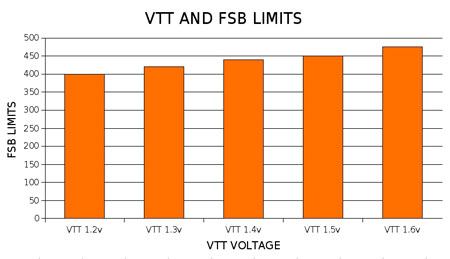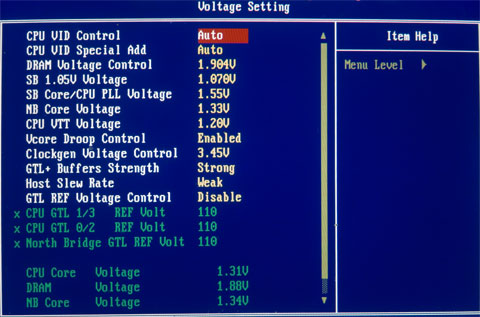DFI UT P35-T2R: Tweakers Rejoice!
by Rajinder Gill on October 18, 2007 2:00 PM EST- Posted in
- Motherboards
Quad-Core Overclocking, continued
Approximate VTT values and FSB ranges
VTT = 1.2V - 1.3V = Up to 400 FSB
VTT= 1.4V - 1.55V = 420-440FSB
VTT=1.6V (~1.58 actual) = 440-475FSB

A few notes on applying values from the VTT/GTL table

1) Fig 1. The first column shows BIOS and actual measured voltages for VTT (first value is measured VTT), the value in brackets is the voltage that must be applied in the BIOS to obtain the measured value. As can be seen, there is a small offset between the BIOS setting of VTT and the actual DMM measured onboard voltage. An average representative figure has been used for the tables. We have found a general variance on boards either 0.1V above or below these figures. Each motherboard will have different sweet spots for GTL values due to this small offset.
2) GTLs set to 66%-70% of VTT seem to be at the most effective point for "stable overclocking" of quad-core CPUs. The highlighted color bar in each VTT/GTL table shows the approximate 67% point of VTT and the corresponding numerical value that needs to be set in the BIOS. We recommend you choose a target FSB range (see the FSB/VTT ranges above) and use the according VTT/GTL scale starting with GTLs @ the 67% values of the applied VTT (the highlighted values in the tables).
The GTL scale voltage values themselves are changed as VTT voltages are raised or lowered by the user in the BIOS. It is necessary to follow the corresponding scale for the set VTT voltage, as looking at the scales above we can see that a level of offset is also applied to the numerical BIOS setting scale.
The 1.2 VTT GTL scale sets 80 GTL digits to a value of 0.80V; however, once VTT is increased to 1.3V the value of 80 GTL digits represents 0.855V. This shows the importance of having the above scales on hand so that we can pick the right values to use when we change VTT.
3) While there is not a universally applicable methodology for tuning GTLs to reach 450FSB+, please note the following:
Approximate VTT values and FSB ranges
VTT = 1.2V - 1.3V = Up to 400 FSB
VTT= 1.4V - 1.55V = 420-440FSB
VTT=1.6V (~1.58 actual) = 440-475FSB

A few notes on applying values from the VTT/GTL table

1) Fig 1. The first column shows BIOS and actual measured voltages for VTT (first value is measured VTT), the value in brackets is the voltage that must be applied in the BIOS to obtain the measured value. As can be seen, there is a small offset between the BIOS setting of VTT and the actual DMM measured onboard voltage. An average representative figure has been used for the tables. We have found a general variance on boards either 0.1V above or below these figures. Each motherboard will have different sweet spots for GTL values due to this small offset.
2) GTLs set to 66%-70% of VTT seem to be at the most effective point for "stable overclocking" of quad-core CPUs. The highlighted color bar in each VTT/GTL table shows the approximate 67% point of VTT and the corresponding numerical value that needs to be set in the BIOS. We recommend you choose a target FSB range (see the FSB/VTT ranges above) and use the according VTT/GTL scale starting with GTLs @ the 67% values of the applied VTT (the highlighted values in the tables).
The GTL scale voltage values themselves are changed as VTT voltages are raised or lowered by the user in the BIOS. It is necessary to follow the corresponding scale for the set VTT voltage, as looking at the scales above we can see that a level of offset is also applied to the numerical BIOS setting scale.
The 1.2 VTT GTL scale sets 80 GTL digits to a value of 0.80V; however, once VTT is increased to 1.3V the value of 80 GTL digits represents 0.855V. This shows the importance of having the above scales on hand so that we can pick the right values to use when we change VTT.
3) While there is not a universally applicable methodology for tuning GTLs to reach 450FSB+, please note the following:
- The default BIOS VTT value is 1.2V and the GTL controls are "DISABLED" in the BIOS by default. Once "ENABLED" is selected the GTL values will automatically default to 110/110/110. These values DO NOT represent a 67% level of 1.2V VTT. Furthermore it is important not to leave this control disabled at any time while tweaking VTT/GTL settings, even if the 67% mark happens to fall at 110/110/110. (Set them manually!) You will need to readjust the GTLs to represent the correct percentage by using the appropriate scale.
- Our tests revealed that CPU load testing failures generally occurred when CPU temperatures exceeded 65C or so. Over 65C it becomes ever more difficult to tune GTL voltages as there is always some uncertainty pertaining to the cause of a CPU core failure: Was it temperature or VTT/GTL related?
- Use active cooling on the Northbridge. Load temps need to remain under 45C to ensure stability in Prime type tests.
- VNB needs to be around 1.61V to 1.65V for 450FSB upwards if using the 266 strap with a Performance Level of 6, which is recommended as memory speed performance per volt is at its best for 2GB. Using 4GB configurations, the 1333/800 strap/divider with a Performance level of 7 works very well.










30 Comments
View All Comments
Acanthus - Thursday, October 18, 2007 - link
Although all of the tweaking options provided are nice, it literally does no better than Asus P5K Deluxe or the Gigabyte P35-DQ6.Furthermore with X38 boards on the way, im not seeing a whole lot of incentive for this $300 motherboard.
Just my $.02
retrospooty - Thursday, October 18, 2007 - link
This board has hit 672mhz FSB, far FAR higher than any other other board ever, including early samples of X38. Not likely to be matched until the DFI X38 comes out.http://www.xtremesystems.org/forums/showthread.php...">http://www.xtremesystems.org/forums/showthread.php...
This link shows it at 666mhz, I cant find the 672mhz one at the moment, but its on the same forum, by the same guy with the same golden CPU.
cmdrdredd - Thursday, October 18, 2007 - link
Not usable 24/7WHO CARES!?
retrospooty - Thursday, October 18, 2007 - link
Well, it still goes alot higher than the others you mentioned, it is absolutely the best overclocking motherboard available. - that was what I responded too, obviously its not the one for you.Acanthus - Thursday, October 18, 2007 - link
That is from the DFI labs... with a beta board... on supercooling...and volt mods... on a dual core CPU that doesnt stress the PWMs...Anandtechs results even using phase dont approach those results.
retrospooty - Friday, October 19, 2007 - link
No, that is not from DFI labs, that is an independant dood, and CPU's that hit that high FSB are pretty rare.Whatever man, you can poo poo it all you want. It is the best OC mobo out there, and goes higher and takes it farther than any other. It may not be the one for you though.
Raja Gill - Thursday, October 18, 2007 - link
You need to remember that this board was compared at stock settings, not OC'ed, things change up top...;), not to mention we could not get the board to crash..regards
Raja
Acanthus - Thursday, October 18, 2007 - link
Its the same chipset, its not going magically increase in a non-linear fashion.The P5K and DQ6 hit the same maximum overclock.
MadBoris - Thursday, October 18, 2007 - link
It makes sense that article takes a different approach, customers of this board or tweakers in general, will really appreciate the fine details.Personally, in the last ten years I have gotten to a place where I am very comfortable not pushing for the last 100 - 300 mhz. The meager tangible return is not worth all the extra voltage or potential stability issues that often come up later in the life of the HW due to creep, dust, aging paste, etc. I get a nice stress test capable OC, then back it up a notch. I won't win any 3dmark awards that way though but am very satisfied with stability when a new product stresses HW in ways not stressed before.
One thing for sure with this board, I wouldn't want to lose the CMOS, then have to remember all my settings after a year.
Nice board and good article, $300 is too much though for a MB for me. It's definitely elite.
retrospooty - Thursday, October 18, 2007 - link
Its alot of reading, but that is because the DFI is alot of motherboard. I have had it since it was first released and loving every minute of it. I have a C2D 6750 running at 8x500 fsb for a sweet 4 ghz on water at DDR2 1000 4-4-4-10 timing, man is it sweet.There are sooooo many bios tweaks to get better performance, or stability at high overclock - its definitely not for beginners... worth every penny of the $300 I spent.